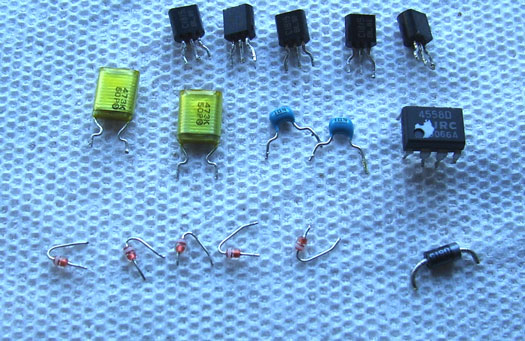In our recent TS808HW feature, we compared the limited handwired unit along with the standard reissue TS808, the Maxon OD808, and an original TS808 from 1980. The results from the test overall were clear: while the TS808HW is a fantastic pedal, the vintage TS808 had the most dynamics, the longest sustain, and was judged the most transparent from 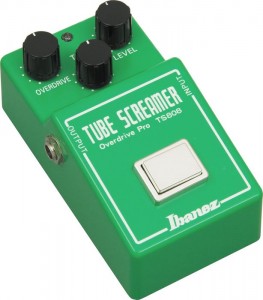 bottom end to top end. This surprised us (because some of us felt that vintage Tube Screamers were mostly unwarranted hype), but it also set in motion a question that drove our curiosity further. Could one of us get the reissue TS808 to sound and feel like the original TS808 – a pedal that as of this writing in late 2008 regularly sells for between $400-$600 USD?
bottom end to top end. This surprised us (because some of us felt that vintage Tube Screamers were mostly unwarranted hype), but it also set in motion a question that drove our curiosity further. Could one of us get the reissue TS808 to sound and feel like the original TS808 – a pedal that as of this writing in late 2008 regularly sells for between $400-$600 USD?
To conduct this test, I needed to source various vintage parts, which can be difficult to do. Fortunately, I have a small supply of original JRC4558D chips with various date codes between 1981 and 1983. Because our original TS808 that I was trying to duplicate had a date coded chip from 1980, I opted to simply use the oldest JRC in my collection closest to that date, and went with the 1981.
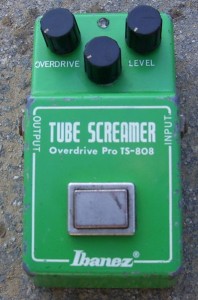 The Tube Screamer circuit also uses diodes in portions of its circuit, both for its clipping circuit, as well as along with its field effect transistors, which in total help shape the response and feel of the circuit. I saw that the reissue TS808 uses diodes that are different in type and physical size. While a diode is a simple component that essentially allows current to travel in one direction, but not another, the vintage TS808 uses diodes that are elongated and closer in size to a 1/8 watt resistor. And we wanted to match those.
The Tube Screamer circuit also uses diodes in portions of its circuit, both for its clipping circuit, as well as along with its field effect transistors, which in total help shape the response and feel of the circuit. I saw that the reissue TS808 uses diodes that are different in type and physical size. While a diode is a simple component that essentially allows current to travel in one direction, but not another, the vintage TS808 uses diodes that are elongated and closer in size to a 1/8 watt resistor. And we wanted to match those.
As far as the transistors, the reissue TS808 uses larger units marked “C1815” while the original TS808 uses “C2458” transistors. Sourcing these as well as the identical diodes as used in the original TS808 would normally be extremely difficult, but fortunately I have some older “donor” electronics from the early 1980s that provided the correct components I needed.
The final changes made were to replace some of the capacitors. None of the values were changed, but vintage replacement types were used where possible to duplicate the original.
I’ve included a photo graphic of both the original TS808’s board as well as the reissue board with the components marked that were changed. Now, let’s review the changes one by one and provide notes on the differences.
Mod Test #1: The Op Amp
The original vintage Tube Screamer circuit actually used three different op amp chip types, but for the sake of this article, I’m going to stick with testing and discussing only the JRC4558D chip. The reissue 808 is a fine Tube Screamer, but we noted that it just didn’t have as much bass transparency, top end sparkle, or sustain in its overdrive that the original did. How much impact would changing the Op Amp make?
I desoldered the reissue 808’s 2008 JRC4558D chip, soldered in a socket and plugged in the 1981 date-coded JRC and experienced a shift in tone and feel that I would say got us 40% on the way to the original. The warmth of the unit was immediately apparent, but the upper frequency response and overall sustain remained about the same. There was some low-end enhancement which contributed to the warmth, but the vintage unit still had more transparency. Still, all in all, a worthwhile mod and a good start!
Mod Test #2: Diode swap
We changed a total of seven diodes in the circuit, however two of them could probably be judged as being more tone-critical than the others. Below the JRC4558D op amp are a pair of diodes that are set together inversely. This is a key area of the clipping stage of the circuit and will have the strongest effect on the overdrive characteristics versus the other diodes. Indeed playing with various types of diodes here is popular for pedal modders, but again, we were going for true actual vintage 808 tone so we used exact spec vintage diodes here. There were four additional diodes tied along to our transistors along the audio path that we changed, and then we made a final change to the larger vintage type diode used in the power supply. The power supply diode (at the bottom of the board in the photo – though obstructed by wires) would have the least, if any, change in tone or feel, but was done simply because the part was available to us. Otherwise, we’d say this change isn’t necessary.
The diode changes overall increased the smoothness of the overdrive further and helped further provide more articulation during pick attack. The dullness of the reissue 808 was slowing going away. I judged that I was now about 65% there to getting the magic of the original TS808 tone out of our reissue.
Mod Test #3: FET swap
There are a total of seven FETs on a Tube Screamer, but unfortunately we were only able to source five of the original C2458’s. After the swap, we felt it moved us to 75% there, and primarily added benefits again in the pick attack characteristics of the TS808 reissue and provided just a bit more solid bottom end transparency.
Mod Test #4: Capacitor swap
I was somewhat limited here in that I would have liked to have swapped out a couple more capacitors, but I located four that would get us closer to the original types used. When the capacitor changes were made, the upper frequency response was restored to a point where overall, the reissue was 95% there in tone and feel of the original TS808.
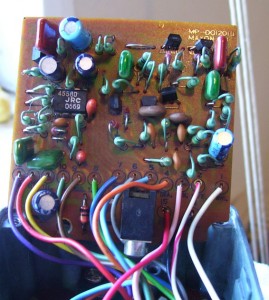
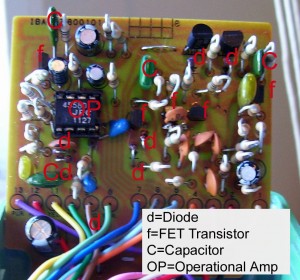
With the mods complete, the top end presence of the reissue TS808 came to life, as did the low-end. The pick attack is strong and the notably midrange-humped reissue now sounds more tonally balanced and dynamic. Is it exactly identical? No, but it is so close that I’m certain nearly anyone who loves the original units would be satisfied. Unfortunately, this is not an easy off-the-shelf series of mods as sourcing the original components was, and will remain, a challenge. However, it was nice to know that obtaining the majority of the mojo and sweet tone of the original TS808 is certainly possible!
